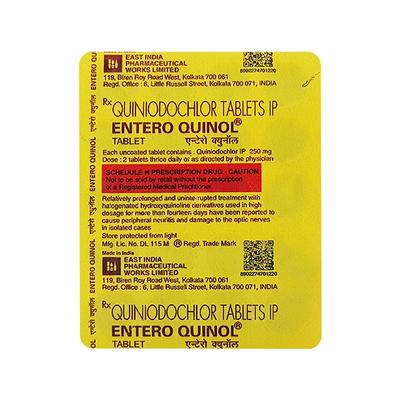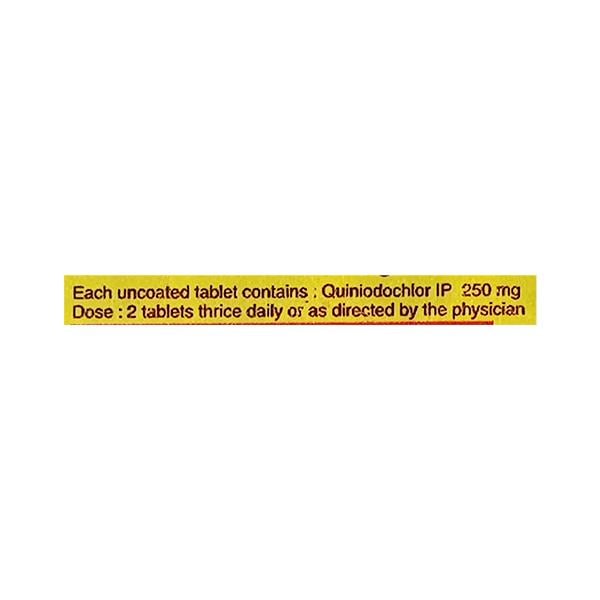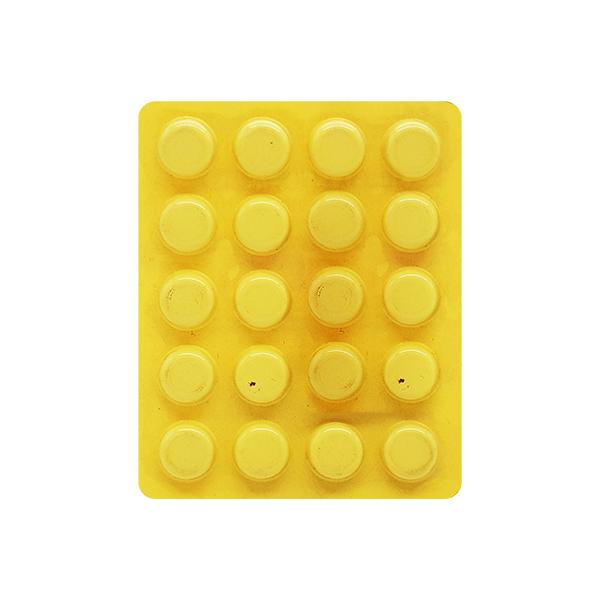

Netmeds First Membership
Quick Links
Introduction About ENTEROQUINOL TABLET
ENTEROQUINOL TABLET contains Quiniodochlor, which belongs to the group of medicines called Antiprotozoals. It is used to manage protozoal infections such as Amoebiasis, Giardiasis and Trichomonas vaginitis in adults.
Amoebiasis is a parasitic infection of the intestine which causes fever, diarrhoea, blood in the stools, nausea, vomiting, weight loss and stomach cramps and Giardiasis is a parasitic intestinal infection characterised by stomach cramps, bloating, nausea and diarrhea.
Trichomonas vaginitis is a type of sexually transmitted parasitic infection of the vagina. Symptoms include foul-smelling vaginal discharge, itching and painful urination.
The risks and benefits of ENTEROQUINOL TABLET for use in pregnancy and breastfeeding are not known. Inform your doctor if you are pregnant or breastfeeding before taking this medicine.
ENTEROQUINOL TABLET is not recommended for use in children as it may cause blindness. Consult your doctor immediately if you experience any unusual side effects while taking this medicine.
Uses Of ENTEROQUINOL TABLET
To manage parasitic infections such as:
- Amoebiasis
- Giardiasis
- Trichomonas vaginitis
How ENTEROQUINOL TABLET Works
ENTEROQUINOL TABLET works by killing the parasitic-producing infective cyst. As a result, it manages and controls parasitic infections in adults.
How to use ENTEROQUINOL TABLET
Take ENTEROQUINOL TABLET as advised by your physician. Swallow the medicines with a glass of water. Do not crush or chew the medicine. Your physician will fix the correct dose and frequency for you based upon your age, body weight and disease condition.
Warning & Precautions
Pregnancy
Consult your doctorThe risks and benefits of ENTEROQUINOL TABLET for use in pregnant women are not known. Inform your doctor if you are pregnant or planning to have a baby before taking ENTEROQUINOL TABLET.
Breastfeeding
Consult your doctorThe risks and benefits of ENTEROQUINOL TABLET for use in breastfeeding mothers are not known. Consult your doctor for advice.
Allergy
ContraindicatedDo not take ENTEROQUINOL TABLET if you are allergic to Quiniodochlor or any other ingredients of this medicine.
Use In Pediatrics
ContraindicatedENTEROQUINOL TABLET is not recommended for use in children as it may cause blindness. Consult your doctor before taking it.
Interactions
A. Drug-Drug interactions:
Before taking ENTEROQUINOL TABLET, inform your doctor if you are taking, have taken or might take any other medicine, including prescription, non-prescription or any herbal medicine.
Overdosage:
If you or anyone else accidentally took too much of ENTEROQUINOL TABLET, consult your doctor immediately or visit the nearby hospital.
Synopsis
| Drug | : | Quiniodochlor |
| Pharmacological Category | : | Antiprotozoals |
| Therapeutic Indication | : | Amoebiasis, Giardiasis and Trichomonas vaginitis |
| Dosage Forms | : | Tablet |
More Information
- Keep ENTEROQUINOL TABLET out of reach of children
- Store ENTEROQUINOL TABLET at room temperature
FAQs About ENTEROQUINOL TABLET
Q: What are the uses of Enteroquinol tablets?
A: Enteroquinol Tablets are used to manage intestinal amoebiasis, a parasitic infection of the intestines caused by Entamoeba histolytica. It helps manage symptoms like diarrhea, abdominal pain, and cramping. Enteroquinol also works as an antiprotozoal agent, effectively targeting protozoal infections in the gut.
Q: How should I take Enteroquinol tablets?
A: Take Enteroquinol Tablets as prescribed by your doctor. Dosage: Typically taken orally, with or without food, as advised by your healthcare provider. Timing: Maintain the prescribed schedule to ensure consistent levels in the body. Duration: Complete the full course, even if symptoms improve early, to ensure complete eradication of the infection. Avoid exceeding the recommended dosage, as prolonged use may cause adverse effects.
Q: What are the possible side effects of Enteroquinol tablets?
A: Common side effects may include nausea or vomiting, loss of appetite, abdominal discomfort and allergic reactions like rashes or itching (in rare cases). Prolonged use or overdose may lead to optic neuropathy or other neurological symptoms like visual disturbances. Report any severe or unusual side effects to your doctor immediately.
Q: Can I take Enteroquinol tablets during pregnancy or while breastfeeding?
A: Enteroquinol Tablets are generally not recommended during pregnancy or breastfeeding unless explicitly prescribed by a doctor. Limited safety data is available, and the risks versus benefits should be carefully assessed by your healthcare provider.
Q: Are there any precautions or warnings associated with Enteroquinol tablets?
A: Avoid long-term use due to the risk of neurological side effects, such as optic nerve damage. Not recommended for individuals with liver disease or severe intestinal conditions unless prescribed. Inform your doctor if you have a history of allergies or other medical conditions. Keep out of reach of children, as accidental overdose can be harmful.
Q: Can Enteroquinol tablets interact with other medications?
A: Enteroquinol may interact with other medications, reducing effectiveness or increasing side effects. Inform your doctor about all medications, supplements, and herbal products you are taking, especially if they include Antimalarials, Antibiotics and Antifungal medications.
Q: What should I do if I miss a dose?
A: If you miss a dose, take it as soon as you remember. If it’s close to your next scheduled dose, skip the missed dose and continue with your regular schedule. Avoid doubling doses to make up for a missed one.
Q: How should I store Enteroquinol tablets?
A: Store Enteroquinol Tablets in a cool, dry place, away from direct sunlight and moisture. Keep them in their original packaging and out of reach of children and pets. Do not use the medication beyond its expiration date.
References
1. KD. Tripathi. Antimicrobial drugs. Essentials of medical pharmacology. 8th Edition. 2019. Page – 898.
2. Prachayasittikul V, Prachayasittikul S, Ruchirawat S, Prachayasittikul V. 8-Hydroxyquinolines: a review of their metal chelating properties and medicinal applications. NIH National Library of Medicine, National Center for Biotechnology Information. PubMed Central. October 2013. [Accessed on 22nd March 2024]. https://www.ncbi.nlm.nih.gov/pmc/articles/PMC3793592/
3. Gera Parul, S.K. Sharma, Bhudiraja Rajat. Colon Targeting Drug - Synthesis and evaluation of prodrugs of Quiniodochlor by -Glucosidase enzyme with HPLC methodology. International Journal of Drug Development and Research. March 2012. [Accessed on 22nd March 2024]. https://www.researchgate.net/publication/288132239_
4. Entero Quinol (Quiniodochlor 250mg). East India Pharmaceutical Works Limited. [Accessed on 22nd March 2024]. https://eastindiapharma.org/therapies/antiprotozoal/entero-quinol/
Useful Diagnostic Tests
- Complete Blood Count (CBC)/ Hemogram
- Complete Health Checkup
- Liver Function Test (LFT)
- Stool Routine And Microscopy Examination
- Serum Electrolytes/ Electrolytes Profile
- Healthians Extended Woman'S Package
- Healthians Extended Male Package
- Healthians Advanced Full Body Checkup - Male
- Netmeds Body Care Plus










